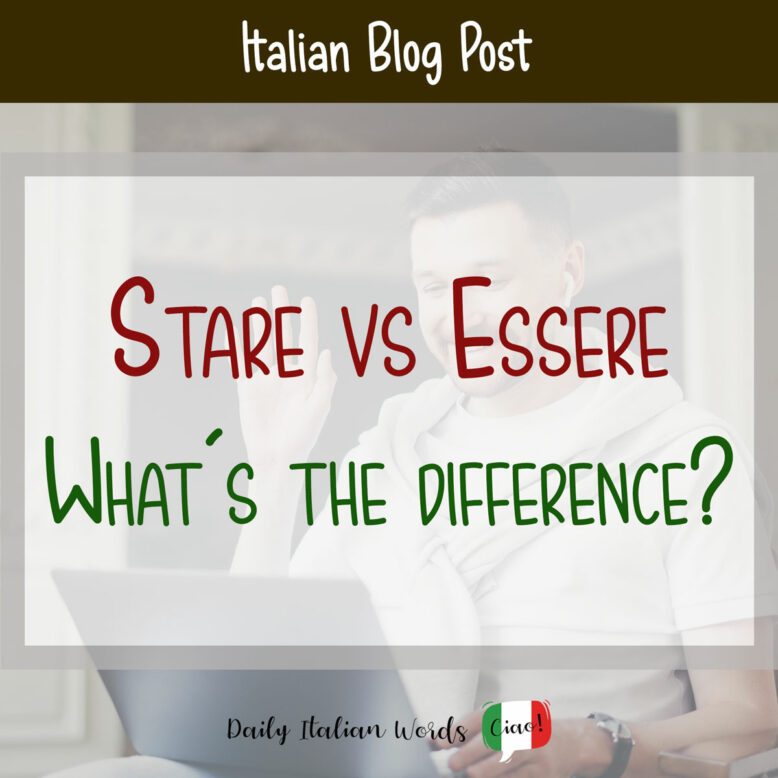The Italian language has multiple verbs that, on the surface, appear to have the same function, but the way in which they are used can be quite different. The reason for this is rooted in their etymology and development which, over time, has changed how these verbs are used today.
One the most misleading verb pairs that never ceases to complicate the lives of Italian students around the world is stare (to stay) and essere (to be).
These two verbs, while at times very similar in meaning, are also sufficiently different that if you mistakenly use one instead of the other, you might as well hold a big sign above your head that says “I’m a learner”!
Jokes aside, it is possible to learn how to distinguish stare and essere – it just takes some time and practice. Here are their main features and some tips on how to deal with these verbs when you encounter them.

The verb “Stare”
Stare is an intransitive verb which has a variety of uses, one of which is “to be still” in a physical place or at a certain moment in time. For example, it can be used in its imperative form to say:
Sta’ ferma!
Stand still!
(lit. Stay still!)
It can also be used to express that one can’t help but do something in particular.
Gianni non può stare senza dire qualcosa di sgradevole.
Gianni can’t help saying something unpleasant.
(lit. Gianna can’t stay without saying something unpleasant.)
Similarly, if the subordinate has the structure non + (auxiliary verb) stare senza + direct object, the meaning reflects something you can’t live without. For example:
Non posso stare senza i miei cani.
I can’t live without my dogs.
(lit. I can’t stay without my dogs.)
Stare can also express a temporary condition of being or staying in a place or a determined condition, such as:
- stare a casa = to stay at home
- stare intorno al fuoco = to stand around the fire
- stare all’aria aperta = to be out in the open air
- stare da solo = to be alone
- stare bene = to be well

In the following example, the verb stare is used to indicate the headquarters of an office, shop or any other entity.
Dove sta il negozio di Armani? – Mi sembra che stia a due passi da via Montenapoleone.
Where is the Armani’s shop? – I think it is close to Montenapoleone Street.
What’s interesting is that in this specific situation, you could also use the verb essere:
Dov’è la sede centrale della Ferrari?
Where are the Ferrari headquarters?
You can use stare to say that you live with someone, you’re engaged or have some kind of friendship or relationship with someone. Additionally, it can be used to show that someone agrees with another person’s ideas or principles.
To better understand this, let’s see some examples:
Massimo sta nello stesso appartamento di Francesca.
Massimo lives in the same apartment of Francesca.
Massimo sta con Francesca da 4 anni.
Massimo has been with Francesca for 4 years.
Sto con te in questa battaglia.
I stand with you in this battle.

An extremely important role stare plays in the grammar of Italian is in the formation of the continuous tense (the equivalent of the English -ing). More specifically, stare in its conjugated form appears before the gerund, which is formed by taking the stem of a verb, and adding either -ando or -endo to the end.
- sto andando (stare + andare “to go”) = I am going
- stiamo ballando (stare + ballare “to dance”) = we are dancing
It is also used to express the concept “to be about to”. Simply place per + infinitive verb after stare in its conjugated form.
Sto per andare.
I’m about to go.
When stare appears with the particle ci, you get the verb starci. In this form, it means a number of different things including “to consent” “to go along with/agree” “to be interested (in someone romantically)” or “to fit (into something)”.
- Non ci sto. = I don’t agree. / I’m not up for it.
- Il libro non ci sta nella borsa. = The book doesn’t fit into the bag.
- Ci può stare. = It makes sense / it’s fitting.
- Maria non ci sta per nulla. = Maria isn’t the least bit interested (in going out with someone).
Finally we have the expression stare a (qualcuno) which means “to be up to (someone)”.
Sta a te decidere se ci andiamo o meno.
It’s up to you whether we go there or not.
These are the main usages of the verb stare in the Italian language. But let’s see how the verb essere behaves in similar situations.
The verb “Essere”
Essere is both an intransitive and auxiliary verb that is etymologically rooted in Latin, and even Sanskrit. Its various meanings are related to the condition of being alive, being real, existing or expressing the quality of something. Like the English “to be”, it can be used to specify your mood, origin and profession. Let’s have a look at some examples:
- Francesco è un medico. = Francesco is a doctor.
- Lui è suo zio. = He is his uncle.
- I conti sono di Milano. = The earls are from Milan.
- Antonio e Mario sono alti. = Antonio and Mario are tall.
- Noi siamo stanchi. = We are tired.
It can be used to determine where someone, something or a place is located. In this sense, it is quite similar to how English uses “to be”.
- Dove sono i libri? = Where are the books?
- Enrico è a casa. = Enrico is at home.
- La costa di Amalfi è in Campania. = The Amalfi coast is in Campania.

The verb essere can also be linked to pronominal particles. When the verb is joined with the particle ci (ci + è = c’è) or ci sono for the plural, you get the equivalent of “there is” and “there are” respectively. They are used to talk about the existence or presence of someone or something.
For instance, non c’è alcun modo di superare l’ostacolo (there isn’t any way to overcome the obstacle), means that a solution does not exist to solve the problem.
In the sentence Al concerto ci sono anche i Maneskin (At the concert Maneskin are there too), the verb indicates the presence of somebody, in this case the rock band. But it can be used also for objects.
You can also use c’è and ci sono to refer to something that is taking place at a certain time, independently of whether it is in the past, present or future. For example:
Oggi c’è una partita di calcio.
Today there is a soccer game.
Finally, the expression ci + essere can be used to express that you’ve arrived somewhere, that you’ve understood something, or that you’re ready. For example, the question Ci sei? (lit. Are you there?) can have all these meanings at once, and only context can clarify the meaning:
- Ci sei? = Did you get there?
- Ci sei? = Do you understand?
- Ci sei? = Are you ready?
But what happens when you have to choose between using stare and essere?
Stare vs Essere
Whether you use one verb or another depends on the meaning you want to convey. Although on some occasions they have to be used properly according to specific grammar rules, in other cases, they can be interchangeable.
When it comes to stare and essere, it can helpful to think about whether you want to express a quality or state, or a voluntary action.
For instance, sono rilassato (I’m relaxed) describes a present condition or state, perhaps true only in the moment it is said. Using sto rilassato, on the other hand, implies that it is your voluntary decision to be that way.
This kind of criteria applies to other contexts too such as la macchina sta in garage (the car is in the garage). This means that the car is in the place where I habitually park it – or in other words, I voluntarily park it there. If you say la macchina è in garage, using essere, you are implying that at that particular moment it is there, but it may be not true later.
Here are a few other examples to help you get your head around the difference:
Sei buono.
You’re good. / You’re a good person.
Referring to a person’s innate quality.
Stai buono!
Behave yourself! / Stay still!
A command used towards children. If the child chooses to behave himself, it becomes a voluntary action.
Sono seduti.
They are seated / sitting down.
This simply describes the state in which the people in question find themselves.
Stanno seduti.
They are seated / sitting down.
This implies that their decision to be seated was voluntary.

Remember, though, that essere is one of two auxiliary verbs (the other being avere) used to conjugate the compound tenses of both essere and stare. This means that the two verbs have the same conjugations in all the forms where the past participle is needed to create a compound tense.
Essere and Stare (perfect tenses):
Sono stato (Present perfect)
Ero stato (Past perfect)
Fui stato (Remote past perfect)
Sarò stato (Future perfect)
The influence of regional dialects
In regional dialects, and therefore in informal conversation, stare can replace essere. You will, for instance, hear native speakers say:
- Giorgio sta a Napoli da anni. = Giorgio has been living in Naples for years.
- Sto contento. = I’m happy.
- Ci sta un cane in cortile. = There’s a dog in the courtyard.
As you can see, Italians don’t always follow traditional grammar rules, especially when influenced by their own regional language or dialect. But luckily for you, this is not something you need to worry much about. And the reason is that, no matter the register, standard Italian grammar doesn’t allow for the swapping of essere and stare in either writing or speaking. It is tolerated only in very informal speech. However, knowing it exists can help you understand people better when you are out and about in Italy.
The correct forms of the previous sentences must use the verb essere:
- Giorgio è a Napoli da anni. = Giorgio has lived in Naples for years.
- Sono contento. = I’m happy.
- C’è un cane in cortile. = There’s a dog in the courtyard.
Conclusion
The difference between stare and essere is very subtle, but improper usage of the two verbs can seriously impact the meaning of a sentence. If you are confused about which one to use, remember that the former describes voluntary actions, whereas the latter should be used to express states, qualities and conditions that are true in the present moment.

Fabio Guarino is a Linguist and Language Specialist who operates as a Freelance Content Writer and SEO Marketer. He considers himself fortunate to be able to blend his passion for his native language, Italian, along with English and Spanish, with his career.


